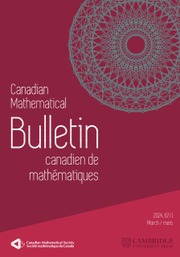No CrossRef data available.
Article contents
Minimal oscillation and vanishing of smooth functions
Published online by Cambridge University Press: 04 September 2025
Abstract
In his paper [2], Ricceri considers, for X bounded convex subset of the real Hilbert space  $ H,$ the quantity
$ H,$ the quantity  $$ \begin{align*}\delta_X = \inf_{\varphi\in \Gamma_X} \Big( \sup_{x\in X} \big(\kern-1.2pt\left\Vert x\right\Vert{}^2 +\varphi(x)\big) - \inf_{x\in X} \big(\kern-1.2pt\left\Vert x\right\Vert{}^2 +\varphi(x) \Big),\end{align*} $$
$$ \begin{align*}\delta_X = \inf_{\varphi\in \Gamma_X} \Big( \sup_{x\in X} \big(\kern-1.2pt\left\Vert x\right\Vert{}^2 +\varphi(x)\big) - \inf_{x\in X} \big(\kern-1.2pt\left\Vert x\right\Vert{}^2 +\varphi(x) \Big),\end{align*} $$ $ \Gamma _X$ denotes the set of real convex functions on X, and shows that
$ \Gamma _X$ denotes the set of real convex functions on X, and shows that  $\delta _X>0$ for
$\delta _X>0$ for  $ X$ non singleton without giving any quantitative estimation of this quantity. And he asks, whether
$ X$ non singleton without giving any quantitative estimation of this quantity. And he asks, whether  $\delta _X$ can be controlled by a function of the diameter of
$\delta _X$ can be controlled by a function of the diameter of  $ X$.
$ X$.
In this article, we show that  $\delta _X$ is exactly the square of the Chebyshev radius of
$\delta _X$ is exactly the square of the Chebyshev radius of  $ X$, hence is at least
$ X$, hence is at least  $\dfrac {\operatorname {\mathrm {{diam}}}(X)^2}4$. We deduce from the main result of [2] a quantitative statement on the zeros of a
$\dfrac {\operatorname {\mathrm {{diam}}}(X)^2}4$. We deduce from the main result of [2] a quantitative statement on the zeros of a  $\mathcal C^1$-operator on
$\mathcal C^1$-operator on  $ H$ with Lipschitz derivative, and show that this statement is optimal.
$ H$ with Lipschitz derivative, and show that this statement is optimal.
MSC classification
Information
- Type
- Article
- Information
- Copyright
- © The Author(s), 2025. Published by Cambridge University Press on behalf of Canadian Mathematical Society


